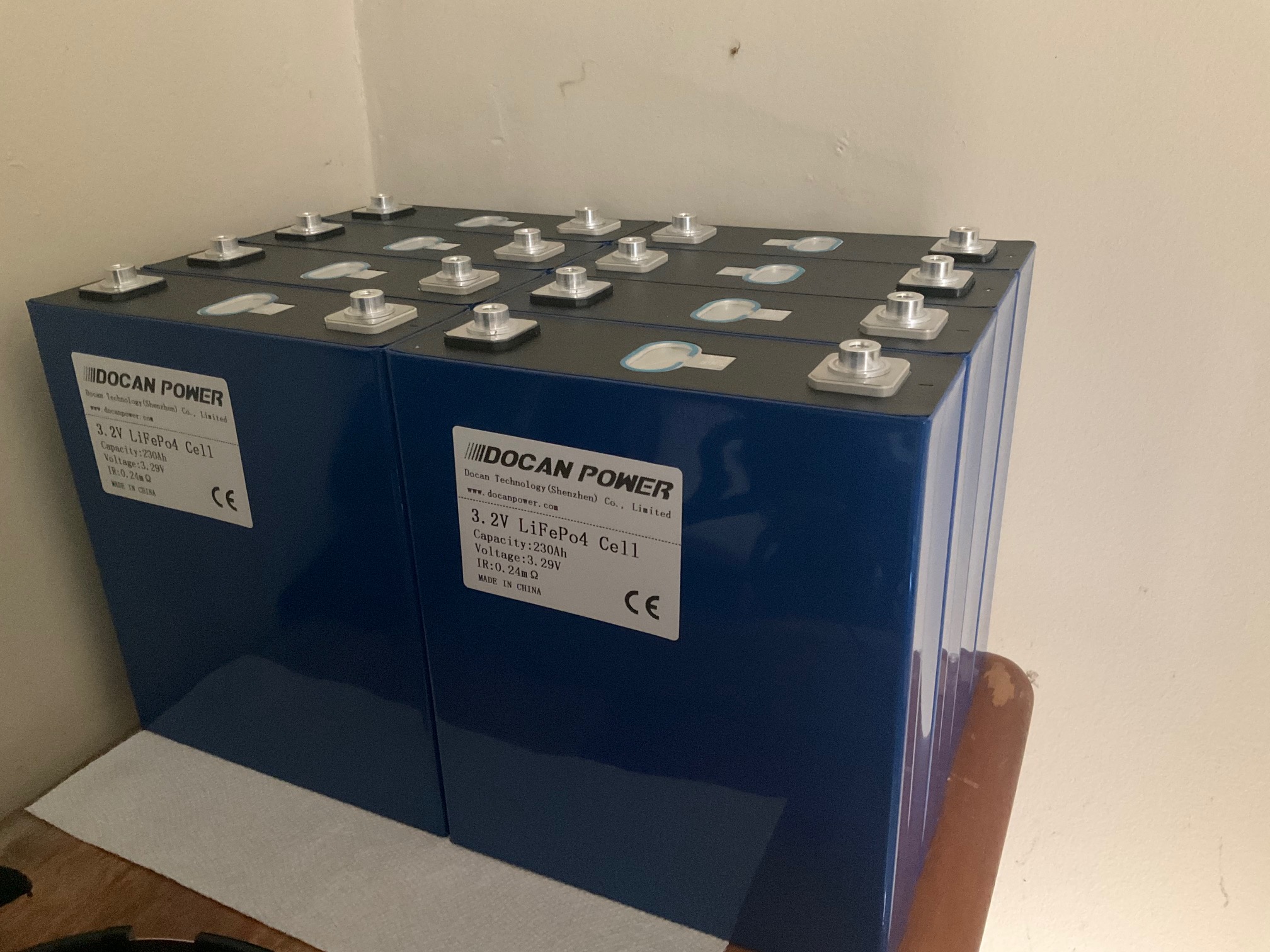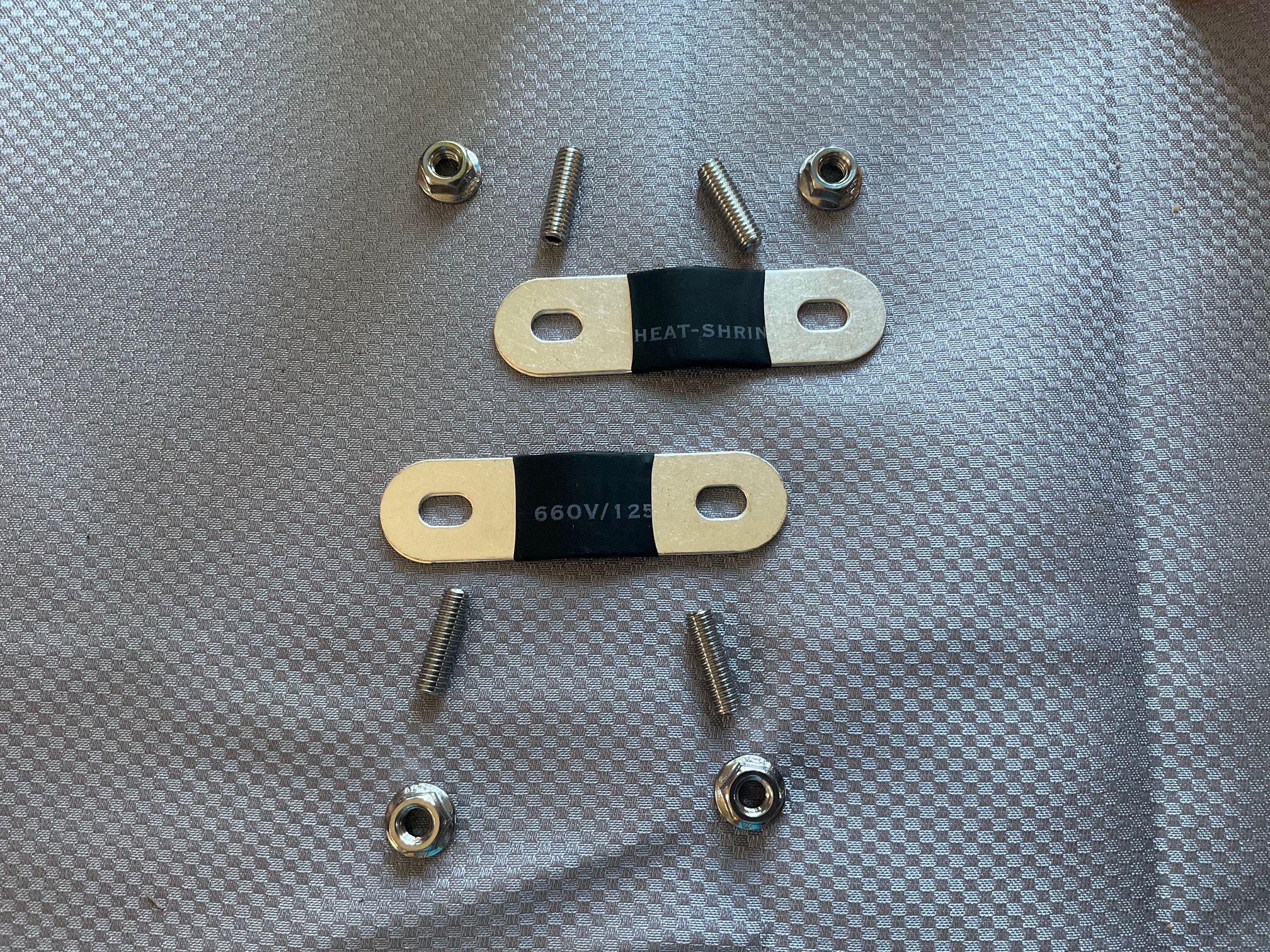Table of Contents
Cerebrational Explorations
DIY LiFePo4 Solar Battery Bank
Project
Objective
Piece together, with a focus on getting to know the process of, sourcing, preparing, building, and eventually operating and using a DIY LiFePo4 battery bank in my off-grid solar setup.
Overview
Backstory
The original environment
In May/June 2017, I had pieced together the following 400W solar power system, from amazon-sourced components:
- 4x 100W Renogy 12V mono PV panels, wired in parallel (12V, ~33A max = 400W at peak/optimum sunlight)
- input voltage: 18.9V
- output voltage: 12V
- Renogy Adventurer 30A PWM controller (12V)
- 3x Universal Power Group 12V 100AH Solar Wind AGM SLA DEEP Cycle batteries, wired in parallel (12V, 300AH; 3840WH)
- BESTEK 1000W Power Inverter Dual AC Outlets 12V DC to 110V AC Car Inverter
- EcoFlow RIVER consumer battery (USB, AC, multiple 12V DC out)
- Wagan 25qt active cooler (40W)
Component Additions
Around 2020 I picked up two EcoFlow Delta 1300 consumer batteries (marketed I guess as a “solar generator”), providing USB (A and C). These each have an integrate MPPT solar charge controller, capable up being charged by a solar panel array up to 65V, 10A.
For a few years, I would charge the delta through a 240W AC adapter plugged into the inverter, and charged the RIVER through the 12V car cigarette port on the delta (and the active cooler through the cigarette port on the RIVER).
Component Upgrades
In March of 2020 I swapped out the original 30A PWM Renogy charge controller with:
- Renogy Advanced Rover Li 40 Amp 12V/24V DC Input MPPT Solar Charge Controller with Bluetooth and LCD screen and multiple LED indicators
There was a notable improvement in efficiency.
Component Replacements/Upgrades
In August of 2020 my original inverter gave up the ghost and let out the magic smoke (literally), and I replaced it with:
- BESTEK 1200W Power Inverter DC 12V to 110V AC Converter with Digital LCD Display 4.2A Dual USB Car Charger
As I had been using the inverter to charge the deltas, I wired up an adequate MC4 cable to plug the delta into the solar array, allowing it to charge at a reduced capacity (12V x 10A = 120W).
Capacity Deficiencies
During the 2021 usage season, I noticed that my solar battery bank capacity was notably reduced.
April 2022
Returning for the season to my off-grid property, and upon making certain realizations, I made the following alterations to my system:
- removed the inverter
- wired the EcoFlow delta into the battery bank
- connected the RIVER to the load terminal of the MPPT charge controller
- replaced the active cooler with a 12/24V DC single zone fridge (Setpower RV45S)
For some reason, despite knowing the battery bank was 12V DC, and my various devices were 12V DC, there had been a cognitive disconnect as to how usable that was (ie I had black-boxed it: and thought I could only access it via the providence of other devices, like the inverter).
So, once I truly realized DC is DC is DC (just know your voltages and amperages), I realized I had no actual need for the inverter, since its primary use case was charging the Delta (effectively, I was doing a 12V DC → AC → 12 DC conversion), so I removed it.
Picked up a simple car DC junction box:
- PSEQT 12 Way Blade Fuse Block with Negative Bus (20A per circuit, 70A max)
Wired the delta into this (15A fuse), with expansion capacity for other devices.
Upgrade: LiFePo4 battery bank
In April 2022, I started investigating in earnest the prospects of upgrading and expanding my solar battery bank capacity. If I now have a true “fridge”, there's a certain logic to letting it be, and powering it 24/7. It won't be on constantly like the cooler, and although it claims to draw ~88W when the compressor is on, reviews on YouTube seem to suggest under normal conditions it may only pull on average about 13WH per day (we'll see).
At any rate, my current SLA battery bank is most certainly not up to the task of running anything at night, and knowing the apparent usable lifespan of such batteries runs from 3-5 years, I'm certainly pushing the outer limits.
I've been reading good things about LiFePo4 batteries, and figured it was time to take the plunge.
After extensive reading, searching, and contemplation, I ordered:
- 8x EVE LF230 230Ah 3.2V LiFePO4 Prismatic Battery Cell Threaded Screw-in Terminal Stud from Docan Power
- 2x RadioB Tech Smart BMS 4S 12V 120A Lifepo4 Lithium Battery Management PCB Protection Board with Balance Leads and Wireless Bluetooth Module - Supports 4 Cells 12.8 Volts DIY Programmable
- 2x NOCO HM327BKS Group 27 Snap-Top Battery Box for Marine, RV, Camper and Trailer Batteries
- 1x DROK DC Buck Converter, 5.3V-32V to 1.2V-32V 12A Adjustable Power Supply, 5v 9v 12v 24V 30V 32V Step Down Voltage Regulator with LCD Display Volt Transformer Reducer CC CV for RV Solar Panel Golf Cart
My intention is to:
- charge the cells
- construct into two 12V 230AH batteries
- top balance each battery
- rewire my panels into series/parallel, to get a 24V system
- wire my batteries in series to get a 24V solar battery bank
- end up with around 5000WH (2760WH x 2 = 5520WH) of capacity, an increase over my current (and diminished) capacity
Log of progress
20220406
- took possession from shipper of the 230AH batteries
- unboxed, inspected
Cells came with bus bars and supporting materials:
Cells each measured 3.28V, and I checked to confirm that terminal polarity was as marked (ie no manufacturing mislabeling of + and -).
20220408
Expecting to take delivery of the DROK DC power supply (DC buck/boost). I know this isn't the optimal way to go about this, but it feels most apropos: it feels cheating to charge the cells outside of my current environment.
So, my plan is to use the DROK to charge the 3.2V cells off my existing battery bank + solar panels.
A thought: top-balancing them once assembled into 12.8V batteries might require an early switchover to 24V. The DROK states it can handle the output voltage, but input voltage needs to be higher.
Comments on amazon state to assume a 90% efficiency of the DROK.
The LiFePo4 cells have a charging voltage of 3.65V, and the DROK has a limit of 120W (and 12A). So off-hand that would seem I've got:
- 3.65V x 12A = 44W
20220412
Started a slow, long-term top balance, 1 partial day at 0.5A, then I was able to upgrade that to closer to 1.5A.
Witnessed cell voltage slowly go from 3.28V to 3.29V and eventually 3.30V.
20220419
I picked up a 10A adjustable DC power supply, and this week have been using that for my charging efforts.
Using that, I've managed to upgrade from 1.5A of charging current to… 1.5A-2A. The quality of the leads seems to be the issue.
20220420
My current obstacle is adequate leads to get a decent amperage.
I cannibalized a computer AC power cable, stripping it down to the copper wire, and wiring that up to the cells and power supply. I also continued to use the existing leads, and got my charging amperage up into the 3A range.
At the end of the charging session, cells were in the 3.30V territory, occasionally flirting with 3.31v when measuring.
20220421
Progress, as I've read and have come to expect, is slow, and not necessarily linear. The key is the amperage, not necessarily the steady progression of the measured voltage (although that, while settling, will seem to rise to some extent, over time based on state of charge).
Presently I am getting 4-5A, the most out of any day so far. I got a better contact of the wires (seeing a pretty consistent value within the range of 15W of power use on the display).
To be sure, learning all sorts of important things with respect to electricity, adding to my corpus of experience. To the onlooker, an otherwise straightforward and uneventful, boring process. But to me, the participant, I'm being informed by all sorts of things. Various details have come into further clarity, and more things are clicking together.
Upped my charge voltage to 3.45V.
Cells seem to be on their way from 3.31V to 3.32V.
20220423
Sourced better leads, although even then, I'm only getting 3.75A. I guess that's what I'm destined to settle with, if only using one set of leads. I jury-rigged a second lead, and am now enjoying 18-20W (5-5.5A), which is more respectable.
Cell voltages drifted back to 3.29V/3.30V.
Ready to take full advantage of this extra day of charging.
20220425
Took advantage of favourable conditions and went roof-top to rewire my panels for 24V operation.
I ended up replacing almost all of the female MC4 connectors, deteriorated through exposure to the elements. I might want to go back and replace the remaining connectors just as a matter of course, a good 5 year update.
I also removed a battery and rewired the battery bank to 24V, just because I could. So, yesterday I experienced operations in 24V, at a peak pulling 9+A from the panels (~220W). I guess time will tell: at peak generation I should be getting 16.66A from the panels.
Shade is likely impeding power generation. Those two trees posing a greater obstacle than before.
20220426
Resuming my battery charging efforts.
Cell voltages had fallen back to 3.30V.
Presently charging to 3.5V, pulling 6.67A (> 20W).
Around 9:30am, cells are all at 3.32V (with one cell showing signs of advancing to 3.33V).
Around 2:30pm, cells are solidly at 3.32V (with some signs of advancing to 3.33V). 6.2A, still over 20W.
20220427
Left it charging overnight.
Cells are now 3.33V, nearing 3.34V. Amperage has dropped to about 5A (17-18W).
Still a far cry from where I'd like things to be.
20220428
Second consecutive overnight. We've been charging solid since Tuesday morning.
Cells have reached 3.35V. Amperage is down to 3.45A (12W).
20220429
First serious run at the cabin. With panels wired for 24V and existing battery bank likewise, on a sunny day as this, I've been beyond pleased with the performance of my system.
Cells drifted back to 3.33V.
Now 4:18pm, cells measure once again at 3.35V (15W).
20220430
Another day of charging at the cabin.
20220501
While the sun is out, getting some charging in.
Each resuming seems to restart us at the 3.32V/3.33V range, and a higher initial amperage (6A, 20W), and then dwindles throughout the day. Cells measuring 3.36V at the end of the day in recent days.
20220503
Started charging the second group of batteries.
20220505
Second group of batteries, charging since Tuesday, are now up to 3.32V.
20220512
After paralleling all 8 on Monday afternoon (20220509), and had upped the voltage to about 3.55V, I arrived today to find them fully charged at 3.4V (0A, 0W!)
So, I upped it to 3.65V and left them to charge. Had a nice 7A+ going. Not sure if I am keen on leaving them to charge through Saturday. We will see. Pleased though that we seem to be wonderfully close to complete with this endeavour.



